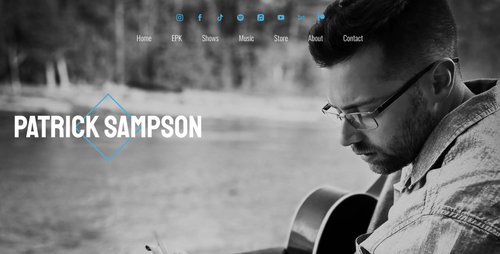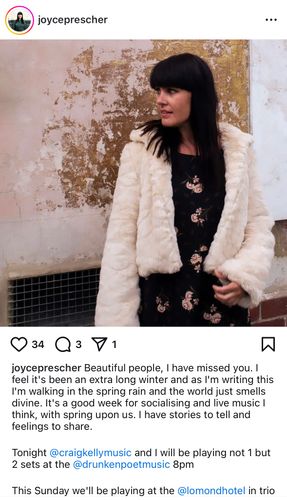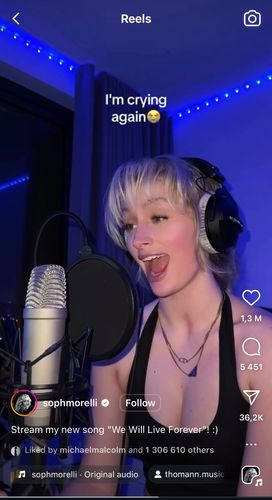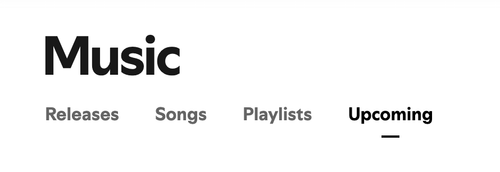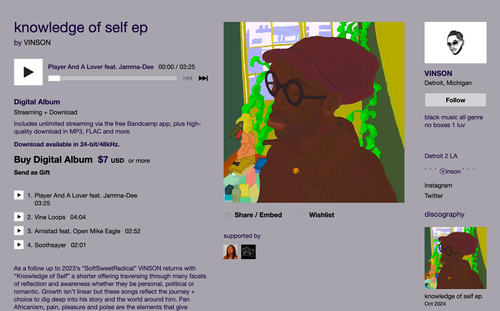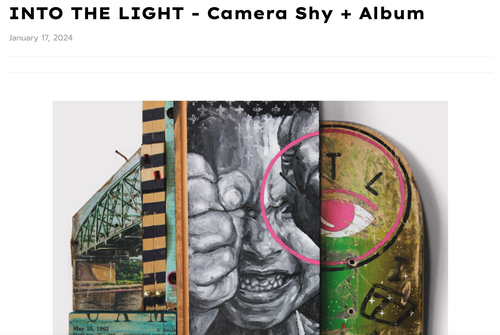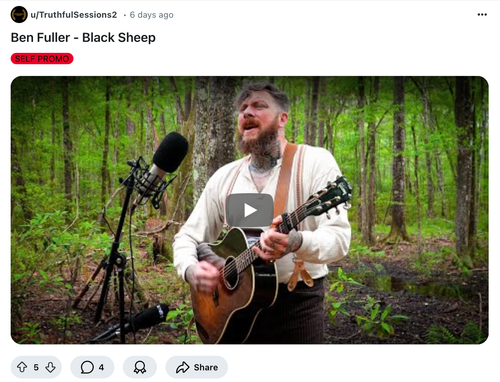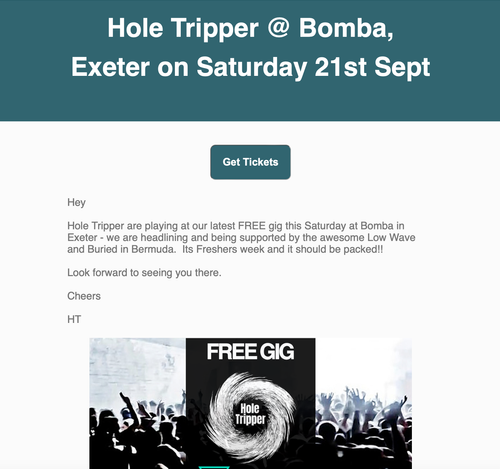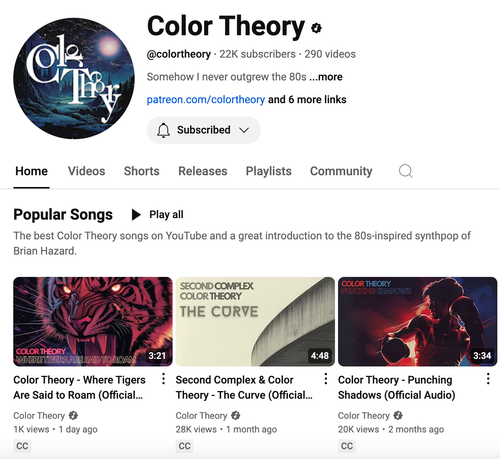As an independent musician, effective promotion is key to expanding your fanbase and reaching new listeners. We’ve compiled strategies that can boost your visibility, whether you’re preparing for a release or focused on long-term growth. Use this checklist to track what you’ve already done and plan what’s next.
Btw, it’s perfectly okay to skip the tactics that don’t feel great about. You should always focus on the promotional methods you feel comfortable with.
0. Website
Before exploring other channels, it’s a good idea to have a website in place. Whether you get assistance from experts or use tools like Wix or WordPress, a simple, sleek site with contact details, press photos, and maybe an EPK or bio is pretty much a must these days. If you’re aiming to be taken seriously, having one is absolutely something to consider – but, of course, you CAN exist without it.
1. Social media
Social media is one of your most powerful tools, offering global reach for free (though it will take time, effort, and sometimes even a paid boost for more reach). Don't forget about:
⌧ Regular posts:
Share updates, behind-the-scenes content, teasers, and reminders. Consistent posting (whether it’s daily, a few times a week, or whatever works for you) on platforms like Instagram, Facebook, Threads, and X/Twitter keeps you visible and top-of-mind. Every release deserves its own dedicated post.
⌧ Stories:
Use Instagram and Facebook Stories for dynamic, quick content. Share links to new or older releases, thank curators for playlist features, give snapshots of what you're up to, or run fun polls to keep your audience engaged.
⌧ Reels
Reels and TikToks are ideal for engaging vertical video content – think teasers, commentaries, or behind-the-scenes clips. Always include a clear CTA (like directing viewers to listen on Spotify). And don't give up even if you don't reach millions in one go, as you never know – a reel could eventually spark something viral, but even more important than that is... consistency!
⌧ Live sessions:
Hosting live performances, updates (e.g., before gigs), or Q&A sessions on platforms like Twitch, Instagram, TikTok, or YouTube (whichever fits your audience) helps build a deeper connection through real-time interaction.
⌧ Collaborations:
Partnering with other musicians, influencers, or visual artists isn’t just for songs. Co-creating content can expand your reach to their audience and vice versa. Think about doing a stitch, reaction video, or a simple reshare (if nothing else feels right).
⌧ Contests & giveaways:
Contests and giveaways can enhance engagement and expand your audience. Encourage fans to participate in something fun related to your track or to join your email list for a chance to win exclusive merch, free tickets, and more.
Avoid overwhelming your fans with requests, though – asking for too many actions, like “like, share, and comment on the post + like this song on Spotify and send proof,” can come off as cheap and excessive.
2. Music/streaming platforms
Getting your music on streaming platforms is important for reaching new listeners and maintaining relevance. Here are some key points to remember for both new and older releases:
⌧ Spotify:
- Pitch your song to Spotify editorial playlists a couple of weeks before your release.
- Don’t overlook independent curators – consider submitting your song in smaller campaigns leading up to your release and even later to revive older tracks.
- You can also create your own playlist featuring your songs alongside artists you admire to help trigger the algorithms and drive organic traffic.
- Remember to add Spotify Canvas visuals for extra engagement.
- And keep your artist profile polished with an updated bio, photos, merch, gigs, and relevant links.
- Pro tip: Mention similar artists in your About section (For fans of…) using an “@” to signal to Spotify where you fit.
⌧ Apple Music
Since Apple Music/iTunes pays more, royalties-wise, you might consider investing time and a portion of your budget to promote your Apple Music artist profile, your latest release, or your own Apple Music playlist (at least on your socials). Adding a second link to your ads targeting your Spotify audience can help redirect some listeners to Apple Music, too.
⌧ Amazon, Deezer:
Applying for editorial playlist placements on these platforms cannot hurt – so it's worth keeping in mind. Amazon allows you to pitch two songs, including a recent release, while Deezer's editorial pitching is similar to Spotify’s process and needs to be done at least one week prior to release.
⌧ YouTube:
Don’t just rely on the topic release your distributor uploads – upload your song directly to YouTube, too. If you can, create an official music video that stands out; if not, a lyric video is a great alternative. Acoustic versions filmed “in your kitchen” or “from the bed” are excellent for shorts and can be reused as snippets on your socials, too. Almost any content you create for YouTube can be reshared and used for ads.
⌧ Bandcamp & SoundCloud:
These platforms cater to different, often niche music communities. Being active on them can help you connect with music lovers while providing important links for bloggers and curators. If you’re looking to reach out to bloggers on Hypemachine, they will need a Bandcamp or SoundCloud link from you, so it’s a good idea to have one ready.
3. Music blogs/press
Getting your music featured on blogs and in the press boosts your credibility and helps you reach a wider audience. This approach is more effective in the long run, allowing you to build awareness of your brand with every release – plus, it helps with your SEO. So consider the following:
⌧ Press releases:
Have a press release prepared for any new single, EP, or album. This will help bloggers and journalists tell your story, whether you link to it in your SubmitHub About section or send it around in email pitches. However, avoid mass emailing generic templates – be sure to customize your pitch if you choose to go this route!
⌧ Blog submissions:
Submitting to music blogs works best with a newer or unreleased track. Ensure you have some information about yourself ready, ideally an EPK (Electronic Press Kit). Don’t forget to include recent pictures, a bio, links to your socials and streaming platforms, as well as a SoundCloud or Bandcamp link for blogs that listen on Hypemachine. Bloggers aren't detectives, and they'll appreciate having the right information easily accessible – it can lead to more coverage for your music now AND in the future (if you're easy enough to work with).
⌧ EP/Album reviews:
Not all bloggers will rush to cover entire albums or EPs (unless you're already big), but at the same time, these bigger releases do deserve quality coverage. You can use SubmitHub’s Marketplace to get quotes for professional reviews if you’re releasing an EP or album. Alternatively, reach out to blogs that have featured your music in the past, letting them know the song is part of a larger project, and express your interest in discussing it further if they’d be willing to write about it.
⌧ Interviews:
Interviews provide an in-depth look at your music and personal story. If you have established connections with blogs or YouTube channels, consider inquiring about doing an interview to showcase your personality and the story behind your latest music.
4. Live performances
Live shows remain one of the most effective ways to build a fanbase and showcase your skills as a musician. They can be instrumental in getting your new music out there, whether by teasing it or playing it live before its release, or starting or finishing a set with a new tune while sharing the news or the story behind it with your audience. Consider these approaches to gigging:
⌧ Gigs:
Playing at local venues or events helps you gain visibility. Smaller venues are typically easier to secure gigs at, and as you gain experience, you can mention these performances to bigger venues to level up your opportunities. Indie on the Move is a great resource to help you find available gigs.
⌧ Online concerts:
Virtual performances on platforms like Twitch, YouTube, or Instagram Live allow you to reach fans without the hassle of travel. You can host intimate sessions, promote new songs in an acoustic setup, or even try out some cover songs or unreleased material (assessing its likeability).
⌧ Festivals:
Don’t hesitate to apply for festival performances, starting with smaller ones. It’s an excellent way to get noticed and network within the industry. The worst outcome is simply a “no,” but the potential benefits of exposure and connections are worth the effort.
5. Advertising
If you have the budget (and you *should* allocate some funds for every release if you want to promote it effectively), investing in ads, particularly Meta ads, can significantly boost your music's visibility. Targeted advertising approach can help you reach a more intentional audience who are likely to listen to your music, providing long-term value. Start with:
⌧ Social media ads:
Targeted Meta ads on Instagram and Facebook can help you reach potential new fans and grow your followers. You can also try TikTok ads, though they tend to be more expensive and may not work as effectively for everyone – but you won’t know until you give it a shot.
Customize your ads for your audience and always include a strong call to action, whether it’s to listen to your new release, follow your artist profile, or save your “This Is” playlist. For more information on setting up a SubmitHub Links landing page with a Meta pixel and running Meta ads, check out this article.
⌧ Google ads:
Google ads are particularly effective for promoting music videos on YouTube or directing fans to your website. Be sure to have a clear goal in mind when setting them up to maximize effectiveness.
⌧ Spotify ads:
Spotify’s Marquee and Showcase ads can work well, especially for promoting new releases to users who have already engaged with your music. Keep in mind that the cost per conversion may be higher than Meta ads, and you have less control over the results.
6. Networking
Building relationships within the music community can open up new opportunities, provide inspiration, and help you improve your craft. Worst-case scenario, you “just” gain a few new listeners. Consider trying out the following:
⌧ Reddit (and similar music forums):
Sharing your music in relevant subreddits or forums – think genre-related (like r/CountryMusic) or lifestyle-related (like r/CowboyHats) – can help with getting feedback, finding new fans, and also potential collaborators. Engage with other artists and listeners, not just by asking them to listen to your new song (though that’s part of it). Comment on others' music, showcase your new hat or guitar, and mention you got them during your last gig. The promotion can happen naturally through conversation – and also through feedback submreddits (such as r/MusicFeedback).
⌧ Collaborations:
Partnering with other artists to create new music can lead to shared audiences and new listeners for everyone involved. Think about collaborative singles, EPs, or remixes to reach each other's fans while bringing something fresh to your own audience.
7. Email Marketing
Email marketing allows for direct communication with your fans, free from algorithm limitations. Although it may take time to build, this method can bring significant results without a cost. Don’t overlook:
⌧ Newsletters:
Start building an email list from your website and socials. Offer value to your subscribers with exclusive content (like early access to new music), appreciation messages, and engagement opportunities (like asking for opinions or letting your fans choose the next single). A dosed, engaging approach keeps the communication balanced, rather than feeling like you are just pushing promotional material.
⌧ A cool email signature:
Add a bit of branding to your emails with a picture, catchy slogan, or another personal touch in your signature. Include a link to your latest release or another important highlight. It’s a subtle way to promote your music in all your email communications.
8. Merchandise
Merch is more than just an extra revenue stream (though it can work well in that regard) – it’s also a key part of your branding and a way for your fans to support you while showcasing their dedication to your music. Consider these aspects:
⌧ Uniqueness:
Whether it’s a stylish t-shirt, vinyl, or custom design, focus on merchandise that truly reflects your brand and stands out from generic templates. Offering unique and well-designed physical items allows fans to connect with you, and even boast about it, so put in the effort to ensure your merch genuinely represents you and is boast-worthy.
⌧ Availability:
Merch should be reasonably priced (which doesn’t mean cheap) and accessible, even for fans in different countries. Ensure that your merchandise is easy enough to order online. Also, having physical items available at concerts can only enhance the experience for attendees.
9. Music videos
Music videos are a staple of visual content, and as such, deserve their own marketing part (and consideration). They will be reaching different audiences – since not everyone uses Spotify. They don’t have to break the bank either – here are some approaches to creating video content:
⌧ Music video:
If you have the resources and time, producing an official music video to accompany your song can make a significant impact. It provides ample content for social media, great snippets for Meta ads, and adds interest to your editorial or curator pitches (so don't forget to mention it).
⌧ Lyric video:
If a full music video isn’t feasible, consider creating a lyric video. These are easier to produce and still offer engaging visual content. You’ll need a mood (shot by you or sourced from a free stock database), an appealing filter or two, and your lyrics.
The free CapCut software, for example, can help you put it all together. Alternatively, you can explore options on the SubmitHub Marketplace.
⌧ Using your video for content:
When you do have a music or lyric video, be sure to maximize its potential. Create teasers, introduce your new release, and use different parts of the video for ads.
10. Other promotional activities
⌧ Fan support/crowdfunding:
Crowdfunding platforms like Patreon enable you to secure direct financial support from your most dedicated fans. It’s important to consistently offer exclusive content or experiences to provide value to your supporters.
⌧ Sync licensing:
Getting your song placed in movies, TV shows, or commercials can be a lucrative, albeit competitive, opportunity. While researching platforms to pitch your music for sync opportunities can be time-consuming, and the results often frustrating due to market saturation, a successful placement can lead to long-term exposure and financial gain.
___
Did we help? Or is there anything we missed? Share what you think is a must in your marketing activities. Wishing you a lot of success with your releases!
 &Tilly
&Tilly